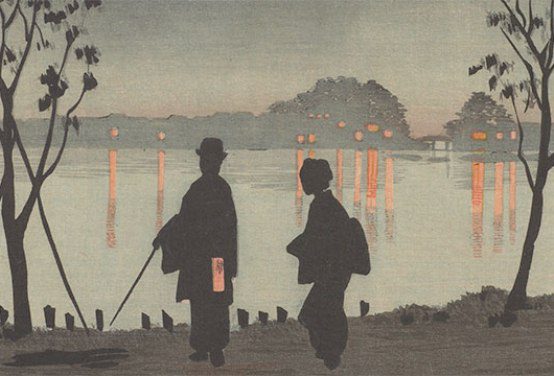Geishas By Gaslight: Kobayashi Kiyochika at the Freer Gallery

The Freer Gallery named their show of wood-block prints by fin de siecle Japanese artist Kobayashi Kiyochika “Master of the Night” (on display through July 27th), but night is ancient and Kiyochika’s work is distinctly modern. His prints show a world in transition. Some of the street scenes might almost be Victorian London; even the rickshaw used to pull a geisha through the night turns out to be a recent import, an innovation. Many of the scenes show people in traditional kimono mixing with bowler-hatted men in Western suits. This was Tokyo, the new capital city, hurrying toward the twentieth century.
Kiyochika’s haunting, color-washed night scenes show him to be on par with Edward Hopper as a poet of artificial light. The show opens with his 1881 “Sumida River by Night,” in which far-off windows glow red, and their light glimmers on the dark river. Gray dusk, slender black trees, and two silhouettes, a kimono-clad and a man in a mix of traditional and Western clothing. Kiyochika’s skies are swathed in slate-blue, gray, and mauve; or they’re jewel-toned, like “Teahouse at Imadobashi by Moonlight,” with its peacock or turquoise sky, glinting water, and drooping fronds. His moons are enormous, surrounded by halos of glowing red or white. He loves to portray light on water: light filtering through umbrellas and broken into shards on the pavement, light caught and gleaming in a river. “Rainy Moon at Gohanmatsu” is a title which gives the general mood of many of these pieces.
The perspective is typically somewhat remote. We’re observers, not participants. The people are usually silhouettes; if they do have faces, these faces are turned away from the viewer. The mood is one of longing, watching–a hushed, secluded feeling in which people mostly fail to connect with one another or with the viewer. It’s a nostalgic feeling, sweetly melancholy, with that characteristic modern edge of alienation. The rain which falls so frequently in these pictures not only lets Kiyochika play with light; it also isolates his people as they run past huddled under their umbrellas.
“Distant View of Ichinohashi Bridge from Sumida River’s Embankment” is a stellar example of this mood. In silhouette, two runners pull a geisha in a rickshaw along the riverbank. Although their running legs and forward-leaning bodies might suggest urgency, the moon glows serenely and from the right side of the frame yearning, curving branches stretch overhead. These curving lines soften the angular lines of the runners and make the scene feel quieter, somehow muffled.
Kiyochika depicted steamboats and warships—more light on the water, this time from cannon fire—and 1879’s propulsive “View of Takanawa Ushimachi Under a Shrouded Moon” shows blood-red smoke coming from a locomotive. The train’s headlights make an artificial dawn. Kimonos under telegraph wires, gas lamps partly hidden by crooked pines. Soot-gray clouds drift in the background. It’s easy to make a firefly-filled night out on a pleasure boat look beautiful, and this show will give you some lovely images of that; but Kiyochika was also capable of 1881’s “Taro Inari Shrine at the Akasuka Rice Fields,” in which a lone figure wanders away (or approaches) under a high full moon. The trees are sparse and bare, the buildings are falling apart, and there is only this small anonymous person under the starless sky.
1881 was a terrible year for Tokyo, and for Kiyochika. Fire swept through the city twice that winter. It destroyed Kiyochika’s home, birthplace, and studio. He made several prints showing the fire itself and the devastation it left behind: This show includes “Great Ryogoku Fire at Akusabashi,” in which enormous scarlet flames stream toward the sky, splotched with purple smoke; tiny people on the ground struggle to salvage something or simply to escape in boats. The fire in “Great Fire in Ryogoku Drawn from Hamacho” is cosmic, a Milky Way of lavender, lemon, pink, slate-blue, and red, with burning black bits fluttering in the huge gusts of flame.
And “Ryogoku After the Fire” made me catch my breath in dismay. Two charred poles are all that is left of the police station; a gas lamp stands untouched in the ruins. Silhouettes wander aimlessly in the shattered landscape, as if paper-thin, blown by the wind.
After the year of fire Kiyochika turned more toward illustration work, including propaganda work during the Sino-Japanese and Russo-Japanese Wars. The Freer show doesn’t include any of this work. We’re left with the ruins, not the turbulent imperial capital which arose from them. Probably better to end the story there, in 1881.
The Freer’s captions are informative, not pushy, and fluent. There’s quite a bit of helpful guidance for Westerners who (like me) lack a background in Japanese artistic traditions or 19th-century technological and political history. The show isn’t large, but it feels spacious; all the prints have room to breathe. It’s a lovely introduction to an artist whose work is full of farewell.
Comments